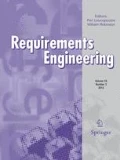Abstract
When producing large systems, it is important that the requirement decomposition process is performed correctly, with requirement traceability maintained. This paper explores this area, using examples from industry to illustrate the problems which can be encountered if traceability/decomposition is not performed correctly. It is hoped that this paper will assist the reader in generating a more precise definition of some general system engineering concerns such as when decomposition needs to be performed, with the requirements hierarchy extended. For the problems covered, this paper also suggests methods by which they can be alleviated or recognised once they have occurred. This additional information is primarily aimed at people who are using tools to manage their requirements, as there may be mechanisms to automate these methods. This paper presents the personal view of the author, based on his many years of experience in this area.
Similar content being viewed by others
References
Mazza C, Fairclough J, Melton B, De Pablo D, Scheffer A, Stevens R. Software engineering standards. Prentice-Hall, Englewood Cliffs, NJ, 1994 (earlier version in 1987)
BS6719. Specifying user requirements for a computer based system, 1986
IEE 830. Guide to software requirements specifications, 1984
IEE 1220. Standard for application and management of the system engineering process, Issue 1
DOD STD 490A. Military standard specification practices, Issue 1
Paulk M, Curtis W, Chrissis M, Weber C. Maturity model for software, Version 1.1, CMU/SEI-93-TR-24. Software Engineering Institute. Pittsburg, PA, 1993
Davis A. Tracing: a simple necessity neglected. IEEE Software 1995; 12(5)
Ramesh B, Powers T, Stubbs C. Implementing requirements traceability: a case study. In: Proceedings of the 2nd IEEE international symposium on requirements engineering (RE 95), York, 1995
Nelsen E. System engineering and requirements allocation. In: Thayer R, Dorfman M (eds), System and software requirements engineering. IEEE Computer Society Press, Washington, DC, 1990.
Hutchings A, Knox S. Creating products customers demand. Commun ACM 195;38(5)
Potts C. Invented requirements and imagined customers: requirements engineering for off-the-shelf software. In: Proceedings of the 2nd IEEE international symposium on requirements engineering (RE 95), York, 1995
Author information
Authors and Affiliations
Corresponding author
Rights and permissions
About this article
Cite this article
Kirkman, D.P. Requirement decomposition and traceability. Requirements Eng 3, 107–114 (1998). https://doi.org/10.1007/BF02919970
Issue Date:
DOI: https://doi.org/10.1007/BF02919970




